Analytical Model for Current–Voltage Characteristics in Perovskite Solar Cells Incorporating Bulk and Surface Recombination
Abstract
:1. Introduction
2. Mathematical Model
3. Results and Discussion
3.1. Effects of Surface Recombination
3.2. Model Fitting with Measurement Data
4. Conclusions
Funding
Data Availability Statement
Conflicts of Interest
References
- Zhang, M.; Chen, Q.; Xue, R.; Zhan, Y.; Wang, C.; Lai, J.; Yang, J.; Lin, H.; Yao, J.; Li, Y.; et al. Reconfiguration of interfacial energy band structure for high-performance inverted structure perovskite solar cells. Nat. Commun. 2019, 10, 4593. [Google Scholar] [CrossRef]
- Wang, R.; Xue, J.; Wang, K.-L.; Wang, Z.-K.; Luo, Y.; Fenning, D.; Xu, G.; Nuryyeva, S.; Huang, T.; Zhao, Y.; et al. Constructive molecular configurations for surface-defect passivation of perovskite photovoltaics. Science 2019, 366, 6472. [Google Scholar] [CrossRef]
- Min, H.; Lee, D.Y.; Kim, J.; Kim, G.; Lee, K.S.; Kim, J.; Paik, M.J.; Kim, Y.K.; Kim, K.S.; Kim, M.G.; et al. Perovskite solar cells with atomically coherent interlayers on SnO2 electrodes. Nature 2021, 598, 444–450. [Google Scholar] [CrossRef] [PubMed]
- Shah, S.A.A.; Sayyad, M.H.; Khan, K.; Sun, J.H.; Guo, Z.Y. Application of MXenes in perovskite solar cells: A short review. Nanomaterials 2021, 11, 2151. [Google Scholar] [CrossRef]
- Lu, Y.B.; Yang, H.; Cong, W.Y.; Zhang, P. Temperature dependence of the effective mass of the hybrid organic-inorganic perovskites CH3NH3PbI3. Appl. Phys. Lett. 2017, 111, 253902. [Google Scholar] [CrossRef]
- Llanos, A.; Thibau, E.S.; Lu, Z.H. Abnormal thin film structures in vapor-phase deposited methylammonium lead iodide perovskite. J. Vac. Sci. Technol. A 2016, 34, 060601. [Google Scholar] [CrossRef]
- Huang, J.; Yuan, Y.; Shao, Y.; Yan, Y. Understanding the physical properties of hybrid perovskites for photovoltaic applications. Nat. Rev. Mater. 2017, 2, 17042. [Google Scholar] [CrossRef]
- Sherkar, T.S.; Momblona, C.; Gil-Escrig, L.; Bolink, H.J.; Koster, L.J.A. Improving Perovskite Solar Cells: Insights From a Validated Device Model. Adv. Energy Mater. 2017, 7, 1602432. [Google Scholar] [CrossRef]
- Sun, X.; Asadpour, R.; Nie, W.; Mohite, A.D.; Alam, M.A. A Physics-based Analytical Model for Perovskite Solar Cells. IEEE J. Photovolt. 2015, 5, 1389–1394. [Google Scholar] [CrossRef]
- Kabir, M.Z. A Physics-Based Analytical Model for Current–Voltage Characteristics of Perovskite Solar Cells Incorporating Bulk Recombination. Energies 2021, 14, 3868. [Google Scholar] [CrossRef]
- Mohseni, H.R.; Dehghanipour, M.; Dehghan, N.; Tamaddon, F.; Ahmadi, M.; Sabet, M.; Behjat, A. Enhancement of the photovoltaic performance and the stability of perovskite solar cells via the modification of electron transport layers with reduced graphene oxide/polyaniline composite. Sol. Energy 2021, 213, 59–66. [Google Scholar] [CrossRef]
- Cao, J.; Wu, B.; Chen, R.; Wu, Y.; Hui, Y.; Mao, B.-W.; Zheng, N. Efficient, Hysteresis-Free, and Stable Perovskite Solar Cells with ZnO as Electron-Transport Layer: Effect of Surface Passivation. Adv. Mater. 2018, 30, 1705596. [Google Scholar] [CrossRef]
- Wang, P.; Li, R.; Chen, B.; Hou, F.; Zhang, J.; Zhao, Y.; Zhang, X. Gradient Energy Alignment Engineering for Planar Perovskite Solar Cells with Efficiency Over 23%. Adv. Mater. 2020, 32, 1905766. [Google Scholar] [CrossRef] [PubMed]
- Zhang, C.-C.; Yuan, S.; Lou, Y.-H.; Liu, Q.-W.; Li, M.; Okada, H.; Wang, Z.-K. Perovskite Films with Reduced Interfacial Strains via a Molecular-Level Flexible Interlayer for Photovoltaic Application. Adv. Mater. 2020, 32, 2001479. [Google Scholar] [CrossRef] [PubMed]
- Shuvoraj, S.M.; Kabir, M.Z. Current–Voltage Characteristics of Perovskite Solar Cells Incorporating Bulk and Surface Recombination: Comparison of a Physics-Based Model Calculations with Experiments. J. Mater. Sci. Mater. Electron. 2024, 35, 191. [Google Scholar] [CrossRef]
- Anjan, M.S.; Kabir, M.Z. Modeling of current-voltage characteristics of CdS/CdTe solar cells. Phys. Status Solidi A 2011, 208, 1813–1816. [Google Scholar] [CrossRef]
- Chen, Y.; Yi, H.T.; Wu, X.; Haroldson, R.; Gartstein, Y.N.; Rodionov, Y.I.; Tikhonov, K.S.; Zakhidov, A.; Zhu, X.-Y.; Podzorov, V. Extended carrier lifetimes and diffusion in hybrid perovskites revealed by Hall effect and photoconductivity measurements. Nat. Commun. 2016, 7, 12253. [Google Scholar] [CrossRef] [PubMed]
- Arnab, S.M.; Kabir, M.Z. An analytical model for analyzing the current-voltage characteristics of bulk heterojunction organic solar cells. J. Appl. Phys. 2014, 115, 034504. [Google Scholar] [CrossRef]
- Hernández-García, L.F.; Cabrera-Arenas, V.; Reséndiz-Mendoza, L.M. On the convergence of the algorithm for simulating organic solar cells. Comput. Phys. Commun. 2015, 196, 372–379. [Google Scholar] [CrossRef]
- Sze, S.M.; Ng, K.K. Physics of Semiconductor Devices, 3rd ed.; Wiley: Hoboken, NJ, USA, 2007; p. 728. [Google Scholar]
- Grundmann, M. Physics of Semiconductors, 3rd ed.; Springer: New York, NY, USA, 2016; pp. 380–381. [Google Scholar]
- Shockley, W. Currents to conductors induced by a moving point charge. J. Appl. Phys. 1938, 9, 635–636. [Google Scholar] [CrossRef]
- He, Z. Review of the Shockley-Ramo theorem and its application in semiconductor gamma-ray detectors. Nucl. Instr. Meth. Phys. Res. A 2001, 463, 250–267. [Google Scholar] [CrossRef]
- Nelson, J. The Physics of Solar Cells; Imperial College Press: London, UK, 2003. [Google Scholar]
- Mannan, M.A.; Anjan, M.S.; Kabir, M.Z. Modeling of the current-voltage characteristics of thin film solar cells. Solid State Electron. 2011, 63, 49–54. [Google Scholar] [CrossRef]
- Saleheen, M.M.; Arnab, S.M.; Kabir, M.Z. Analytical model for voltage-dependent photo and dark currents in bulk heterojunction organic solar cells. Energies 2016, 9, 412. [Google Scholar] [CrossRef]
- National Renewable Energy Laboratory. Available online: http://rredc.nrel.gov/solar/spectra/am1.5/ (accessed on 3 June 2024).
- Bennett, S.H.; Ghosh, J.; Gros-Daillon, E.; Lédée, F.; Guillén, J.M.; Verilhac, J.-M.; Zaccaro, J.; Chung, D.Y.; Klepov, V.; Kanatzidis, M.G.; et al. Charge transport comparison of FA, MA and Cs lead halide perovskite single crystals for radiation detection. Front. Detect. Sci. Technol. 2023, 1, 1249892. [Google Scholar] [CrossRef]
- Motta, C.; El-Mellouhi, F.; Sanvito, S. Charge carrier mobility in hybrid halide perovskites. Sci. Rep. 2015, 5, 12746. [Google Scholar] [CrossRef] [PubMed]
- Brenner, T.M.; Egger, D.A.; Kronik, L.; Hodes, G.; Cahen, D. Hybrid organic–inorganic perovskites: Low-cost semiconductors with intriguing charge-transport properties. Nat. Rev. Mater. 2016, 1, 15007. [Google Scholar] [CrossRef]
- Wu, G.; Liang, R.; Ge, M.; Sun, G.; Zhang, Y.; Xing, G. Surface Passivation Using 2D Perovskites toward Efficient and Stable Perovskite Solar Cells. Adv. Mater. 2022, 34, 2105635. [Google Scholar] [CrossRef]
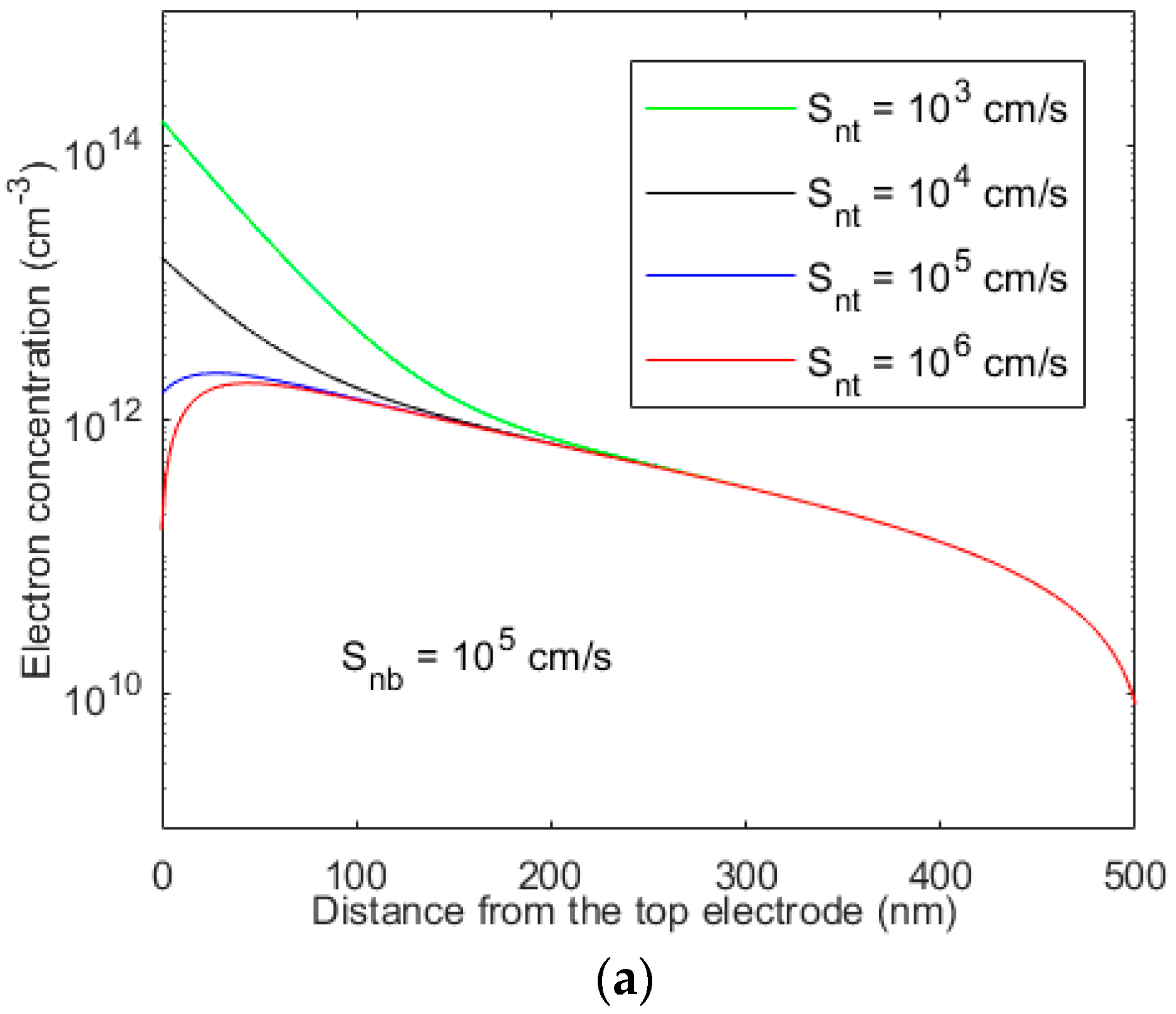
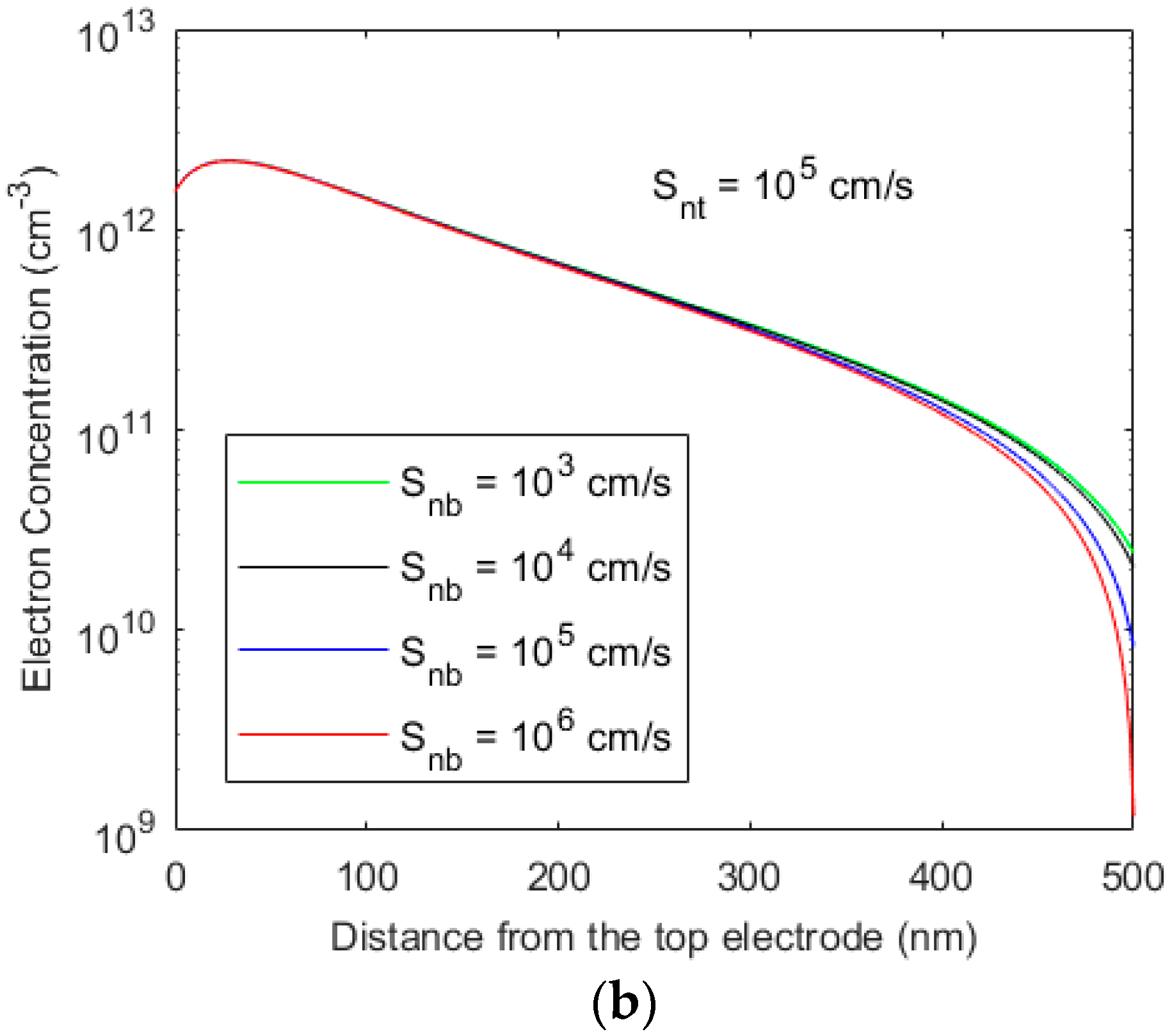
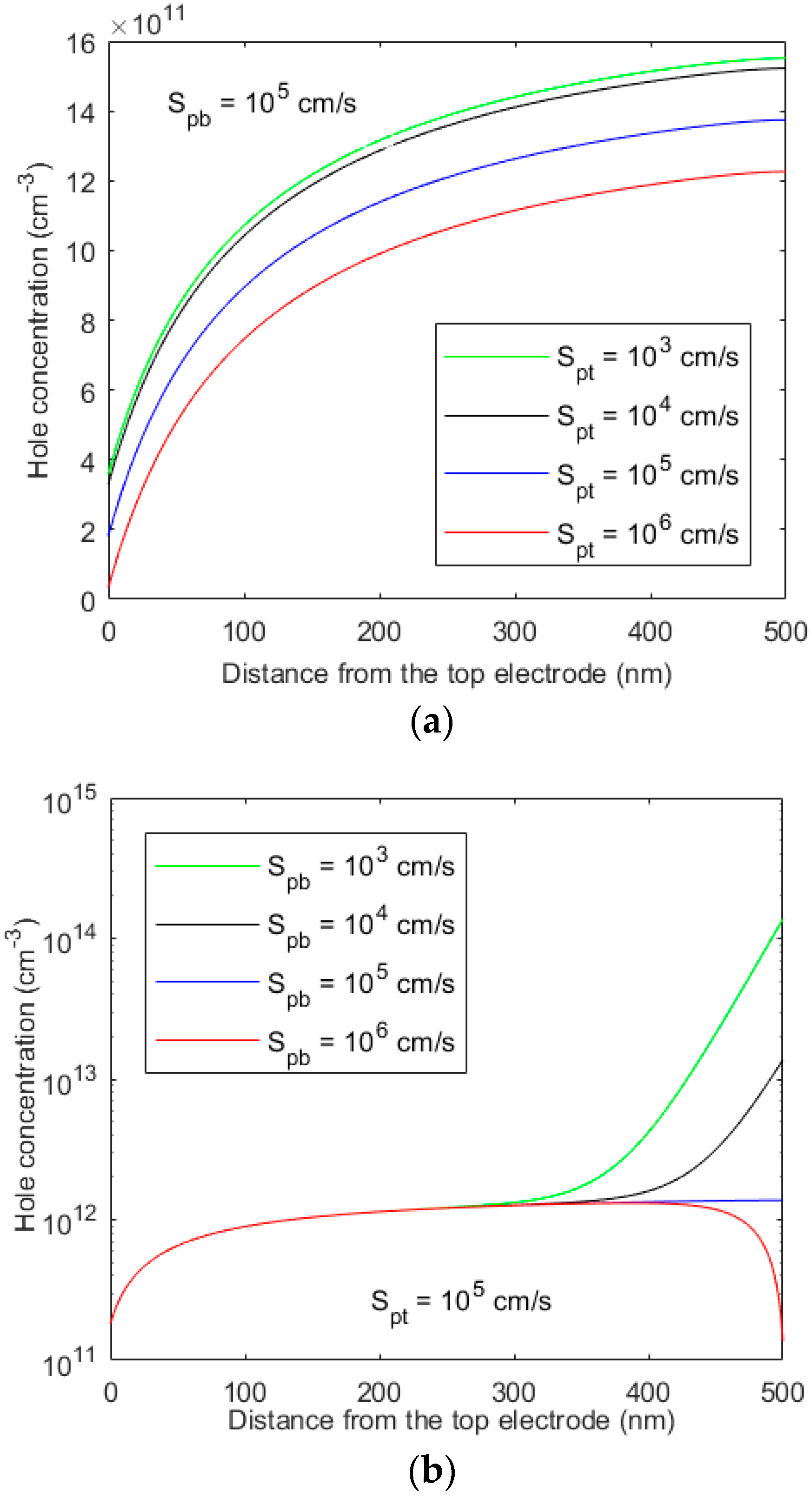
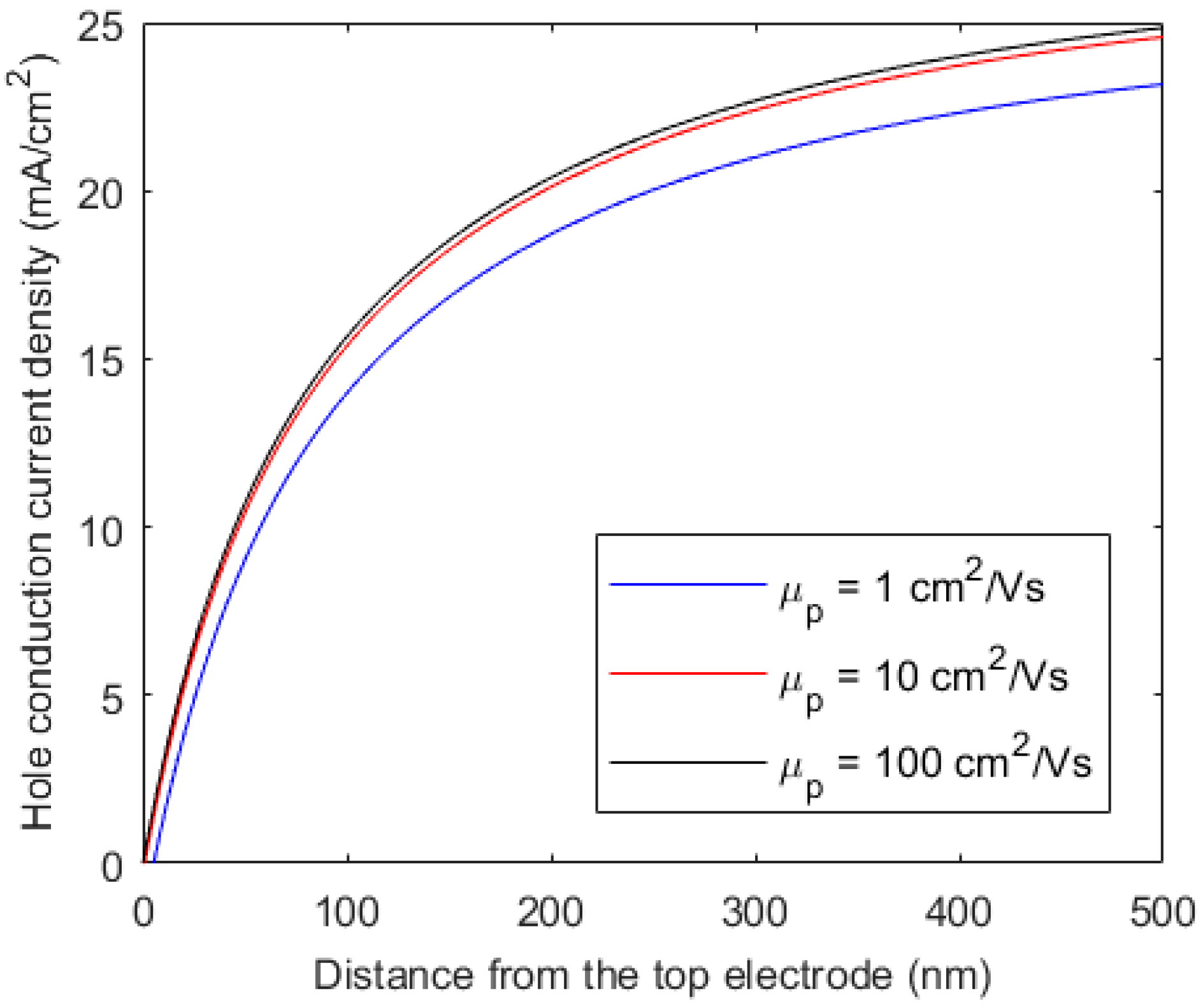

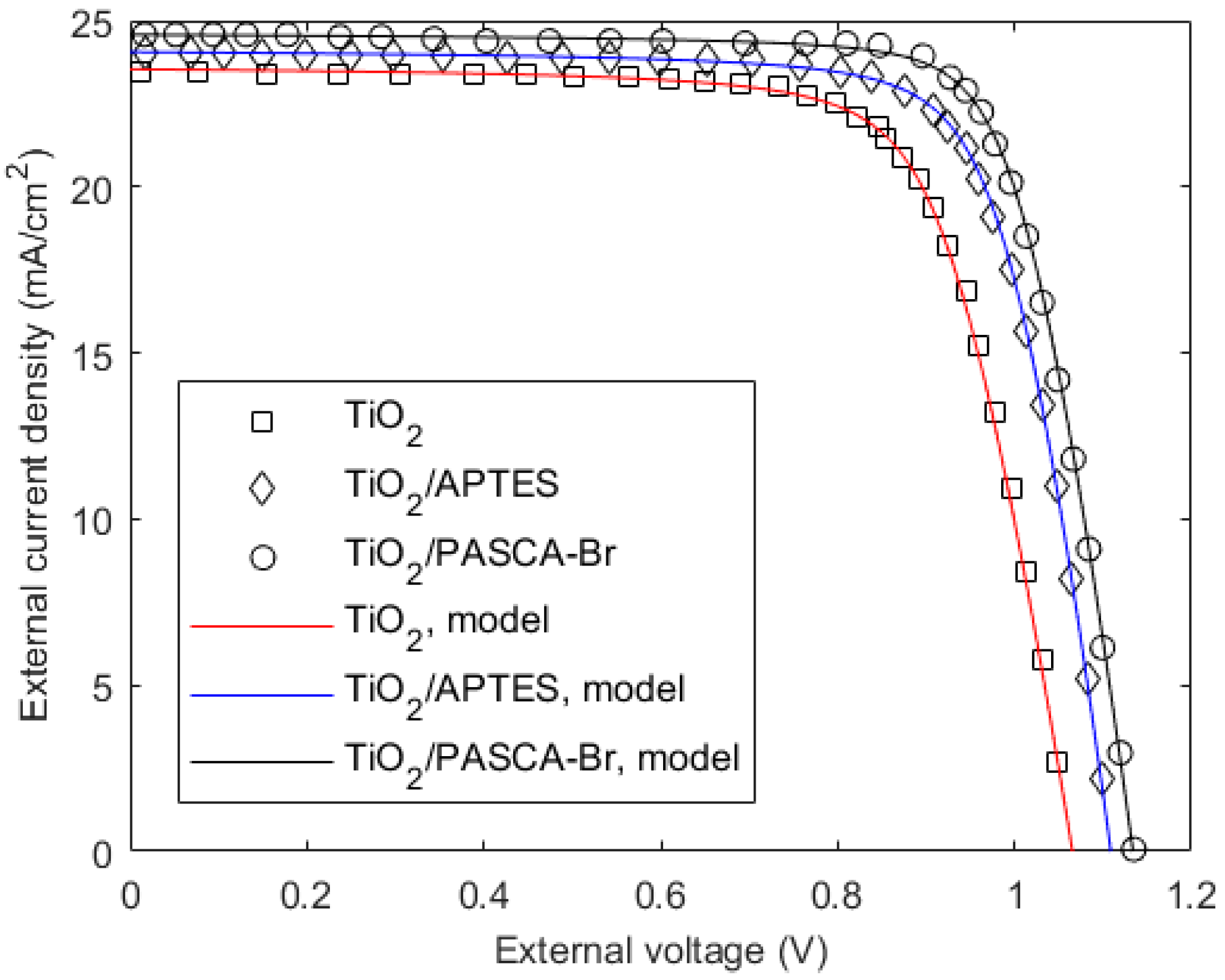
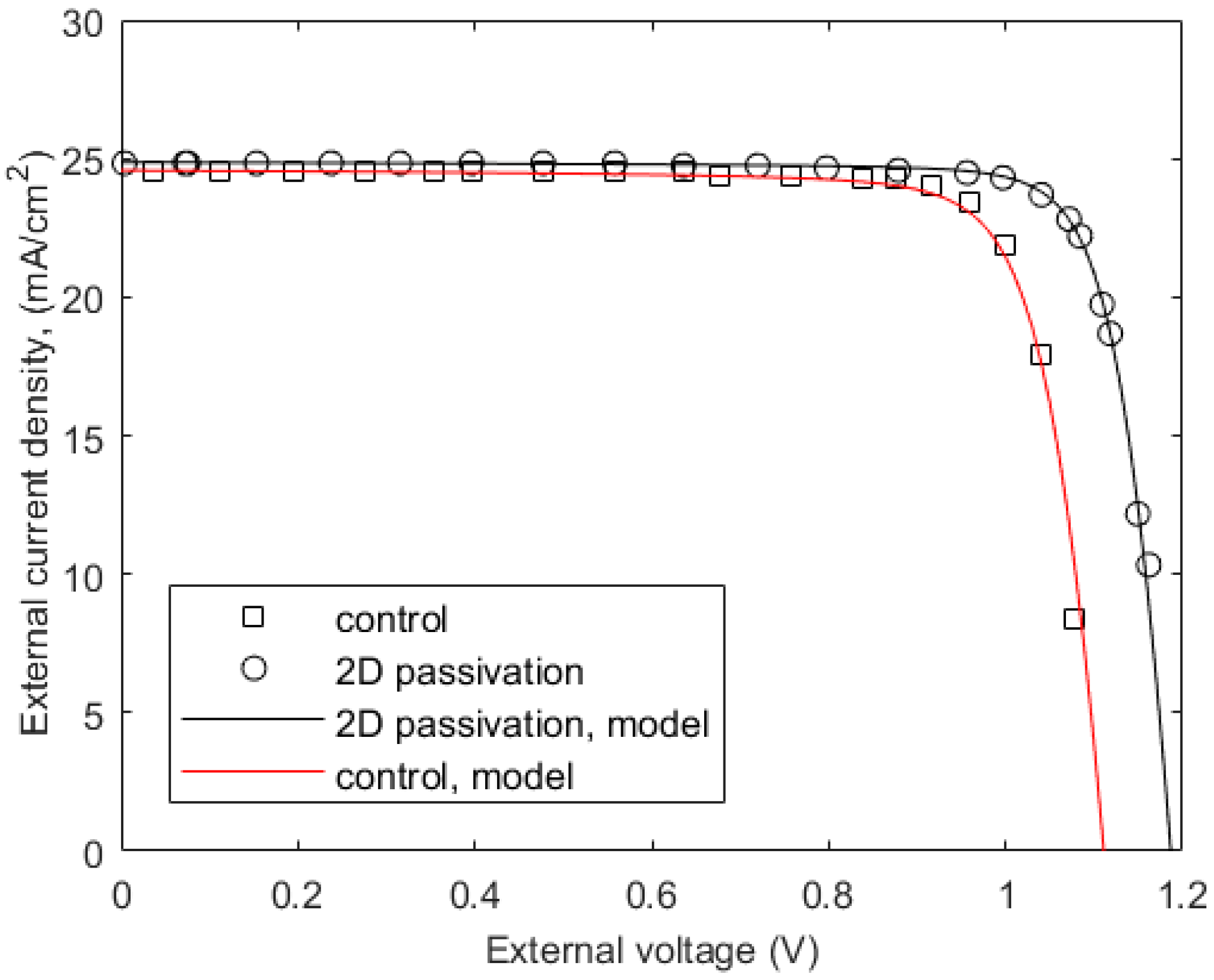
| Bulk Perovskite | ETL/HTL Composition | Vbi (V) | Jc (Acm−2) | Rs (Ωcm2) | Spt = Snt (cms−1) | Spb = Snb (cms−1) | PCE (%) |
|---|---|---|---|---|---|---|---|
| Cs0.05(FA0.83MA 0.17)0.95Pb(I0.83 Br0.17)3 [14] | TIO2 | 1.08 | 1.5 × 10−11 | 4 | 5 × 103 | 5 × 103 | 18.3 |
| TIO2/APTES | 1.13 | 1 × 10−11 | 3.2 | 4 × 103 | 5 × 103 | 20.3 | |
| TIO2/PASCA-Br | 1.15 | 0.5 × 10−11 | 3.2 | 2 × 103 | 5 × 103 | 21.6 | |
| (FAPbI3)0.95(MAPbBr3)0.05 [31] | Control (no 2D passivation) | 1.22 | 4 × 10−11 | 1 | 4 × 102 | 5 × 104 | 22.5 |
| With 2D passivation | 1.22 | 10−12 | 1 | 4 × 102 | 5 × 102 | 24.5 |
Disclaimer/Publisher’s Note: The statements, opinions and data contained in all publications are solely those of the individual author(s) and contributor(s) and not of MDPI and/or the editor(s). MDPI and/or the editor(s) disclaim responsibility for any injury to people or property resulting from any ideas, methods, instructions or products referred to in the content. |
© 2024 by the author. Licensee MDPI, Basel, Switzerland. This article is an open access article distributed under the terms and conditions of the Creative Commons Attribution (CC BY) license (https://creativecommons.org/licenses/by/4.0/).
Share and Cite
Kabir, M.Z. Analytical Model for Current–Voltage Characteristics in Perovskite Solar Cells Incorporating Bulk and Surface Recombination. Micromachines 2024, 15, 972. https://doi.org/10.3390/mi15080972
Kabir MZ. Analytical Model for Current–Voltage Characteristics in Perovskite Solar Cells Incorporating Bulk and Surface Recombination. Micromachines. 2024; 15(8):972. https://doi.org/10.3390/mi15080972
Chicago/Turabian StyleKabir, M. Z. 2024. "Analytical Model for Current–Voltage Characteristics in Perovskite Solar Cells Incorporating Bulk and Surface Recombination" Micromachines 15, no. 8: 972. https://doi.org/10.3390/mi15080972





